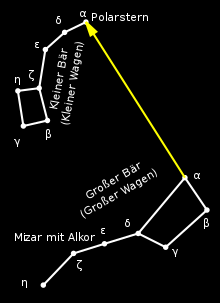Sky clock
Open -eyed methods for determining the approximate time at night are referred to as the sky clock . The best known method uses the box stars of the Big Dipper that point to the North Star .
Imagine a dial with the North Star in the center and read off the "clock hand" (around 5 o'clock in the picture). The further process is as follows:
- add the number of months since the beginning of March to the "time" read
- multiply this sum by 2
- and subtract the result from 24 (or 48)
This results in the approximate CET (or in other time zones the approximate zone time)
- Example for November 16, hand position 5 o'clock
- 5.0 + 8.5 = 13.5
- 13.5 x 2 = 27.0
- 48 - 27.0 = 9.00 p.m. CET.
The same pointer position on October 16 would be 11 p.m. CET (i.e. midnight summer time)
Explanation of the formula
- Multiplication by 2: our "dial" only has 12 hours, whereas the sky rotation takes just under 24 hours
- Subtraction: The starry sky appears to turn counterclockwise
- Month correction: sidereal day lasts 23:56 hours, but the time depends on the sun.
accuracy
With a pointer reading to ¼ hour, the time is accurate to ½ hour. Near the positions "3" and "9", the error is somewhat larger if one proceeds horizontally from the North Star. In fact, one would have to take into account the curved great circle that runs from the Pole Star down to the east or west point of the horizon - then the quarter of an hour can be reached.
The method is strictly only valid for zone meridians (for CET: 15 ° east of Greenwich). At most, 4 minutes must be corrected for each degree of difference in length. E.g. for Hamburg (10 °) add 20 minutes, for Vienna (16 °) subtract 4 minutes.
literature
- Gottfried Gerstbach: Astronomy , Lecture Notes Chapter 1, Vienna University of Technology 2005
- Oswald Thomas : Heaven and Universe , Chapter II. Hardcover 320p., Paul Neff Verlag, Vienna-Stuttgart 1953
